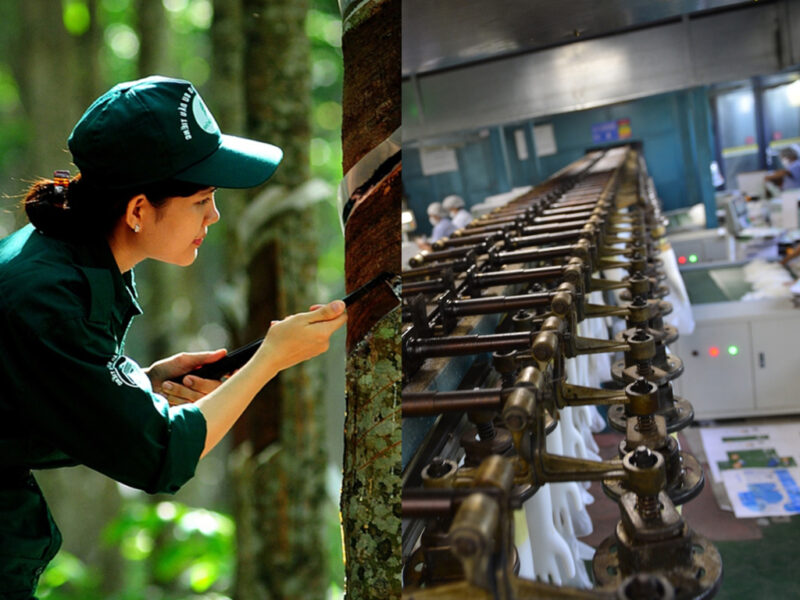
Vietnam’s rubber industry has long been a pillar among key agricultural exports while also making a major contribution to the processing sector. In 2024, the industry recorded a historic high in export value, laying a positive foundation for the next stage of development. Amid tightening global supply and rising demand from major downstream industries, Vietnam’s rubber outlook is considered positive, though it still faces substantial challenges in international markets.
Vietnam’s position in the global rubber market
Vietnam currently ranks among the world’s three largest producers and exporters of natural rubber, alongside Thailand and Indonesia. The country has over 900,000 hectares of rubber plantations, concentrated mainly in the Southeast and Central Highlands regions.
In 2024, natural rubber exports reached around 2 million tons, worth USD 3.4 billion. Including value-added rubber products and rubberwood, total industry export value hit USD 10.2 billion-the highest on record. China remained the largest buyer, accounting for more than 70% of total export volume.

Overview of Vietnam’s rubber prices
In 2024, Vietnam’s export rubber prices rose sharply due to a global supply squeeze. Export prices to China-its largest market-increased from USD 1,388/ton in January to USD 1,905/ton in November, nearly 40% higher year on year. For the full year, the average price reached USD 1,701/ton, up 26% from 2023.
Moving into the first half of 2025, the uptrend continued. According to Customs data, Vietnam exported about 680,000 tons worth USD 1.27 billion-down 6.5% in volume but up 14.4% in value year on year. The average export price was USD 1,865/ton, up 22.4%. In June alone, prices to China reached USD 1,914/ton, higher than those to Malaysia and Côte d’Ivoire but still below Russia and Thailand.
By grade, the market showed clear divergence. SVR3L reached USD 2,128/ton (up 24.4%), while latex averaged USD 1,454/ton (up 21.2%). Although shipments of SVR10 and latex declined, prices remained elevated. A shift toward higher-value products-especially compound rubber (rubber blends)-is helping Vietnam sustain export value growth even when volumes soften.

Trends and outlook for the rubber sector
According to the Vietnam Rubber Association (VRA), total industry export value in 2025 is forecast at around USD 11.0-11.2 billion, up roughly 10% from 2024. This outlook is underpinned by three key drivers:
- Global rubber consumption continues to rise, especially in autos and tire manufacturing.
- Supply disruptions in major producing countries due to weather and disease pressures.
- Domestic companies’ push into deeper processing to enhance value instead of relying on raw-material exports alone.
The industry also has opportunities to expand beyond China as next-generation free trade agreements provide tariff advantages. The shift toward higher-value exports, combined with efforts to meet sustainability standards, will be a critical foundation for maintaining growth in the medium to long term.
Opportunities and challenges
Looking ahead, Vietnam’s rubber sector has significant room to grow as global demand for inputs used in autos, supporting industries, and medical products increases. The shift to deeper processing and the rising bar for sustainable products also opens pathways to lift export value and access more demanding markets.
See also: 11 most important industrial applications of rubber
That said, the sector faces notable challenges. Heavy reliance on a few traditional markets adds policy and demand uncertainty. Intensifying global competition and stricter environmental standards require companies to upgrade technology, ensure transparent supply management, and invest for the long term to maintain Vietnam’s position on the global rubber map.

Solutions for industry development
To sustain growth and consolidate its international standing, Vietnam’s rubber industry should focus on several priorities:
Accelerate downstream processing
Shift from raw-material exports to higher-value products such as tires, gloves, and technical rubber materials. This requires investment in modern processing technology and collaboration with research institutes to meet international standards.
Meet sustainability standards
Build sustainable management systems from planting and tapping through processing; adopt circular agriculture, emissions reduction, and GIS-based management to comply with stringent environmental regulations.
Diversify markets
Leverage FTAs such as EVFTA, CPTPP, and RCEP to penetrate South Asia, the Middle East, and Africa, while tailoring trade promotion to each region’s specifics.
Leverage technology
Advance digital transformation in production and trade; use blockchain for supply-chain transparency, B2B e-commerce to reach global buyers, and big-data analytics for price forecasting and production optimization.
Build a national brand
Position Vietnam’s rubber around quality and sustainability while highlighting cross-industry strengths. Increase visibility at international trade fairs, partner with major global groups, and invest in worldwide communications to enhance credibility.
Vietnam’s rubber industry stands at a pivotal moment, with ample opportunities to expand markets and lift export value. Alongside these positive signals, the sector must also contend with global competition and ever-tighter sustainability standards. Proactive adaptation and a long-term strategy will determine its ability to maintain a strong position in the global supply chain. For more detailed information, please contact Thái Dương Plastics.
Read more: Rubber applications in daily life and their importance
